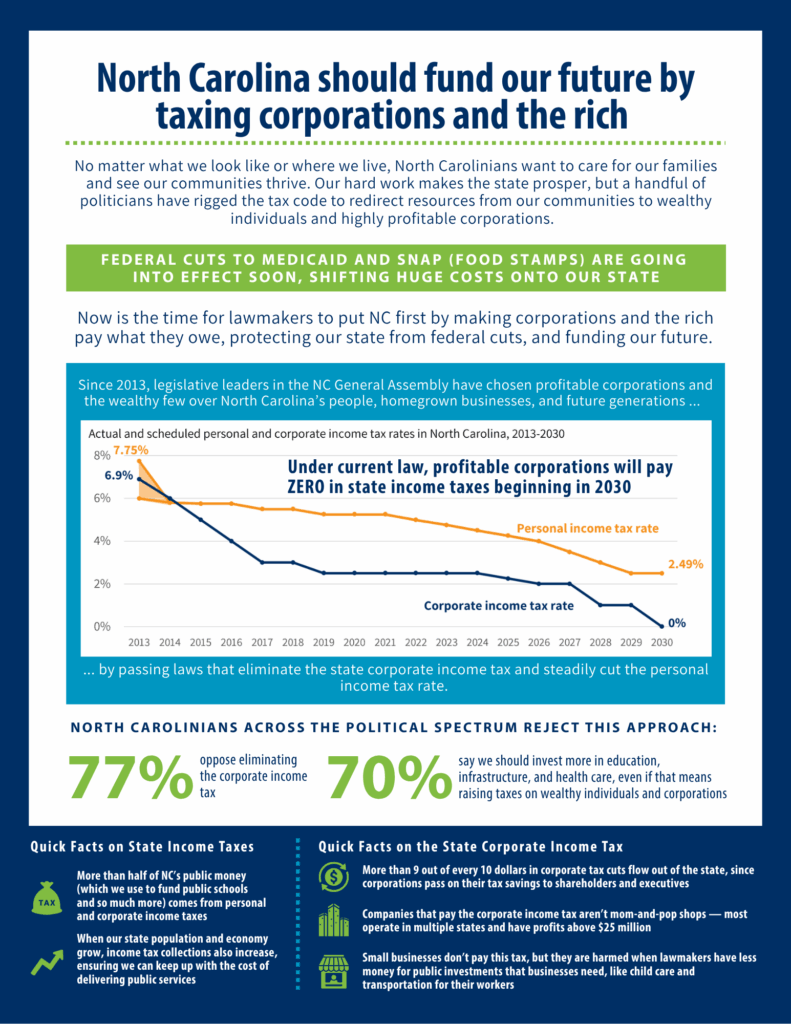Lowering the income tax limit in the state constitution would lock future North Carolinians into today’s bad tax policy

The NC General Assembly is considering a constitutional amendment on the ballot that, if approved by voters in a statewide election, would lower the maximum allowable income tax rate to 5 percent. The state constitution already limits the maximum income tax rate, and enshrining a lower income tax limit would be both unnecessary and harmful for the people of North Carolina.1The state constitution was amended in 2018 to lower the maximum allowable income tax rate from 10 to 7 percent. However, courts have ruled that the amendment was unconstitutional because it was referred to voters by a racially gerrymandered legislature. For the purposes of analysis here we have modelled the more conservative estimate of the impacts of going from a 7 percent to a 5 percent income tax rate. For additional details see Emily Lau, “Supreme Court of North Carolina: 2022 Review and 2023 Preview,” University of Wisconsin Law School State Democracy Research Initiative, January 20, 2023, https://statedemocracy.law.wisc.edu/featured/2023/supreme-court-of-north-carolina-2022-review-and-2023-preview/.
It would have no immediate effect on how much people are paying in taxes, because income tax rates are already under 5 percent: The corporate income tax rate is 2.5 percent and will be completely eliminated by 2030 unless legislators reverse course, and the personal income tax rate is 4.5 percent and is scheduled to fall to 2.5 percent over the next five years. But this tax cap would immediately lock North Carolina into the status quo of a tax code designed to benefit the rich at the expense of funding essential services and increase the likelihood of future harm to the vast majority of North Carolinians.
A 5% income tax limit in our state constitution would:
Further lock North Carolina into an upside-down tax code that benefits the super-rich and highly profitable corporations.
When it comes to state and local taxes, North Carolina already has an upside-down tax code that asks the most from families with the least financial resources. The richest 1 percent of households in our state make well over a million dollars each year on average but pay just 6 percent of their annual income in state and local taxes. Meanwhile, the average household in the bottom 20 percent makes less than $15,000, but still pays 11 percent in taxes — a portion almost twice as high as the millionaires.2“North Carolina: Who Pays? 7th Edition,” Who Pays? (Institute on Taxation and Economic Policy (ITEP), January 9, 2024), https://itep.org/north-carolina-who-pays-7th-edition/.
This amendment would prevent lawmakers from passing a graduated personal income tax that could restore a more equitable tax code by taxing people with very high incomes at a rate over 5 percent. When it comes to the corporate income tax, 90 percent of the financial benefit of blocking a tax rate over 5 percent would flow to people — primarily corporate shareholders — who don’t live in North Carolina.3Special data request to ITEP, June 2024. For the purposes of analysis, we have modelled the more conservative estimate of the impact of lowering the income tax rate from 7 to 5 percent, although courts have ruled that the 2018 amendment which lowered the maximum rate to 7 percent was unconstitutional. See footnote 1 for additional details.
Stricter limits on income taxes also mean a greater reliance on more regressive revenue sources like sales taxes, fines, and fees. People with lower incomes spend a far greater share of their earnings on purchases that are subject to sales tax than wealthy people, and these taxes are already a growing share of state revenue. A lower income tax cap will lock in these bad choices.
Make it harder for our state to provide adequate public services and jeopardize our credit rating
By lowering the income tax cap from 7 percent to 5 percent, this amendment would block our state from generating nearly $9 billion in annual public revenue.4Special data request to ITEP. North Carolina families are already seeing the chaotic impacts of revenue policy that is inadequate to meet community needs: school buses that never arrive, layoffs of school librarians, the elimination of entire academic departments at UNC System schools, and 1,500 child care centers at risk of closure. With an adequate and equitable tax code, our state could address these issues and much more, but a 5 percent income tax cap would make that all but impossible.
When state income tax limits are placed into the constitution, they can also damage a state’s credit rating, making it more expensive for governments to borrow money when needed. Major credit rating agencies in the United States name constitutional limits on taxation as a negative factor when assigning bond ratings because of how severely they constrain government’s options for repaying loans taken out for infrastructure and similar projects.5 “U.S States and Territories Methodology” (Moody’s Investors Services, March 22, 2022), https://www.moodys.com/research/US-States-and-Territories-Methodology–PBM_1299298; “U.S. State Ratings Methodology,” Criteria, Governments: U.S. Public Finance (S&P Global, August 15, 2023), https://disclosure.spglobal.com/ratings/en/regulatory/article/-/view/sourceId/9775517. Not surprisingly, research has found that more restrictive state tax limitations are associated with lower credit ratings and higher borrowing costs.6Judith I. Stallmann et al., “Tax and Expenditure Limitations and State Credit Ratings,” Public Finance Review 40, no. 5 (September 1, 2012): 643–69, https://doi.org/10.1177/1091142112446844; Megan Randall and Kim S. Rueben, “Sustainable Budgeting in the States: Evidence on State Budget Institutions and Practices” (Urban Institute, November 27, 2017), https://www.urban.org/research/publication/sustainable-budgeting-states-evidence-state-budget-institutions-and-practices.
Tie lawmakers’ hands in the future and prevent them from being accountable to their constituents
If the income tax cap in our state constitution is lowered, it will be extremely difficult to undo if future lawmakers choose to invest in our communities or need to respond to an economic crisis. During recessions in the 2000s, North Carolina lawmakers were able to temporarily raise income taxes on people with very high incomes, taking pressure off local governments and generating millions of dollars in funding to support public schools facing budget shortfalls.7Alexandra Forter Sirota, “Income Tax Rate Cap Amendment Is Costly for Taxpayers, Communities,” Budget & Tax Center (North Carolina Justice Center, September 2018), https://www.ncjustice.org/wp-content/uploads/2018/12/BTC-REPORT-tax-amendment-2018.pdf. Research has shown that, if the goal is long-term economic health, raising taxes on people with high incomes is a better strategy than spending cuts during a recession.8 Nicholas Johnson, “Budget Cuts or Tax Increases at the State Level: Which Is Preferable When the Economy Is Weak?” (Center on Budget and Policy Priorities, April 18, 2010), https://www.cbpp.org/research/budget-cuts-or-tax-increases-at-the-state-level.
A lower tax cap would tie lawmakers’ hands, limiting their tools to respond to their constituents’ needs with public funds generated through wise revenue policies.9Bernie Gallagher, “State Limits on Revenues and Budgets Stifle Democracy,” Center on Budget and Policy Priorities: Off the Charts (blog), June 27, 2023, https://www.cbpp.org/blog/state-limits-on-revenues-and-budgets-stifle-democracy. It would also hamstring future elected leaders’ ability to make different policy decisions than the bad ones being made today.
Increase pressure on local governments and property taxes, with rural counties hit the hardest
When state revenue is constrained, researchers have found ripple effects on local revenue as well. Dozens of North Carolina counties, which are overwhelmingly rural, rely on state funds for over 15 percent of their annual budget.10NC Budget & Tax Center analysis of 2023 County Annual Financial Information Reports, available at https://logos.nctreasurer.com/Reporting/Report/External?applicationCode=AFIR These are the counties that will be hit the hardest when state legislators can’t adjust income tax policy to meet funding needs. Facing limited state support, local governments are likely to have few options beyond raising property taxes or cutting services.
Footnotes
- 1The state constitution was amended in 2018 to lower the maximum allowable income tax rate from 10 to 7 percent. However, courts have ruled that the amendment was unconstitutional because it was referred to voters by a racially gerrymandered legislature. For the purposes of analysis here we have modelled the more conservative estimate of the impacts of going from a 7 percent to a 5 percent income tax rate. For additional details see Emily Lau, “Supreme Court of North Carolina: 2022 Review and 2023 Preview,” University of Wisconsin Law School State Democracy Research Initiative, January 20, 2023, https://statedemocracy.law.wisc.edu/featured/2023/supreme-court-of-north-carolina-2022-review-and-2023-preview/.
- 2“North Carolina: Who Pays? 7th Edition,” Who Pays? (Institute on Taxation and Economic Policy (ITEP), January 9, 2024), https://itep.org/north-carolina-who-pays-7th-edition/.
- 3Special data request to ITEP, June 2024. For the purposes of analysis, we have modelled the more conservative estimate of the impact of lowering the income tax rate from 7 to 5 percent, although courts have ruled that the 2018 amendment which lowered the maximum rate to 7 percent was unconstitutional. See footnote 1 for additional details.
- 4Special data request to ITEP.
- 5“U.S States and Territories Methodology” (Moody’s Investors Services, March 22, 2022), https://www.moodys.com/research/US-States-and-Territories-Methodology–PBM_1299298; “U.S. State Ratings Methodology,” Criteria, Governments: U.S. Public Finance (S&P Global, August 15, 2023), https://disclosure.spglobal.com/ratings/en/regulatory/article/-/view/sourceId/9775517.
- 6Judith I. Stallmann et al., “Tax and Expenditure Limitations and State Credit Ratings,” Public Finance Review 40, no. 5 (September 1, 2012): 643–69, https://doi.org/10.1177/1091142112446844; Megan Randall and Kim S. Rueben, “Sustainable Budgeting in the States: Evidence on State Budget Institutions and Practices” (Urban Institute, November 27, 2017), https://www.urban.org/research/publication/sustainable-budgeting-states-evidence-state-budget-institutions-and-practices.
- 7Alexandra Forter Sirota, “Income Tax Rate Cap Amendment Is Costly for Taxpayers, Communities,” Budget & Tax Center (North Carolina Justice Center, September 2018), https://www.ncjustice.org/wp-content/uploads/2018/12/BTC-REPORT-tax-amendment-2018.pdf.
- 8Nicholas Johnson, “Budget Cuts or Tax Increases at the State Level: Which Is Preferable When the Economy Is Weak?” (Center on Budget and Policy Priorities, April 18, 2010), https://www.cbpp.org/research/budget-cuts-or-tax-increases-at-the-state-level.
- 9Bernie Gallagher, “State Limits on Revenues and Budgets Stifle Democracy,” Center on Budget and Policy Priorities: Off the Charts (blog), June 27, 2023, https://www.cbpp.org/blog/state-limits-on-revenues-and-budgets-stifle-democracy.
- 10NC Budget & Tax Center analysis of 2023 County Annual Financial Information Reports, available at https://logos.nctreasurer.com/Reporting/Report/External?applicationCode=AFIR



